The Chinese of Amsterdam
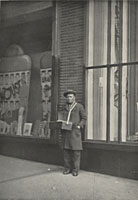
Chinese peanut biscuit seller from: F.van Heek, Chineesche immigranten in Nederland (Amsterdam, 1936)
The Chinese people who arrived in the Netherlands from around 1900 onwards were nearly all seafarers and, in particular, stokers. Yet the Dutch did actually not see much of them. After all, they worked on the steamships of the big shipping companies, such as KNSM, Oceaan and SMN. Between contracts, they resided at boarding houses in Rotterdam and Amsterdam. In Rotterdam, where, for a long time, the Chinese minority had been far larger than in Amsterdam, the Chinese population concentrated itself on the Katendrecht. In Amsterdam, the Chinese community lived in and around the Binnen Bantammerstraat. The Chinese seamen were greatly favoured by the shipping companies because of their low wages; in 1911 the Chinese sailors were kept in reserve as strike-breakers during the major seaman's strike. The Chinese sailors tended to be signed up as a group per ship. The contact person was simply called 'number one', frequently this was the 1st stoker and he was usually the only one in the team who spoke a bit of English or, more rarely, a bit of Dutch. The manager of the boarding house usually acted as the shipping master. He entered into a contract with number one, who ensured that the rest of the group was available. The pay was around 70% of a Dutch sailor's earnings. However, 90% of these wages went to the shipping master for mediation, board and lodging and credit.
The Dutch public only really became familiar with the Chinese when resourceful laid-off seamen began to sell peanut biscuits on the streets in 1931.
The economic crisis had left the stokers stuck unemployed in their boarding houses. The shipping industry's transition from steam to diesel made their prospects even bleaker. The pauperisation of these poor seafarers, who were already rather impoverished, and even hunger hit them hard. They had no legal status or support. At the time, the Dutch government actively took steps to involuntarily repatriate them to China. It is believed that during the 1930s one thousand Chinese people, among whom the elderly and sick, were forcibly repatriated to their homeland.
Restaurants
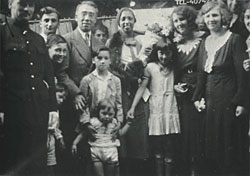
Josephine Baker in front of the Kong Hing restaurant, 1932.
Another offshoot of this industriousness, which would later become highly conspicuous, emerged on the eve of the crisis: Chinese restaurants. In 1928, the first Chinese restaurant, which also attracted Dutch diners, was opened in the Binnen Bantammerstraat. The owner was Ng Ho Yong, who had exchanged his boarding house for the restaurant business. His eatery 'Kong Hing' became a great success. Indeed, the American singer and dancer Josephine Baker visited the restaurant various times and even allowed herself to be photographed in its doorway in 1932.
The group who remained active in the Netherlands after the difficult years of the Second World War was almost exclusively involved in the restaurant business. During the period of post-war reconstruction, the great rise of the 'Chinese' began in earnest. According to a norm established by the Ministry of Economic Affairs in 1980, it was deemed that every Dutch town or district with more than 10,000 inhabitants should have its own Chinese restaurant.
The Chinese population consequently grew during this reconstruction period, but also continued to increase in numbers long after. The group had now been expanded with people from Hong Kong and the 'new territories', regions from which the Chinese people who were already present had also originally come. The legal status of the Chinese differed from the other immigrants and paved the way to illegal migration. In 1975, Toorenaar, the Amsterdam chief police commissioner, estimated the number of illegal Chinese people in the city at 5,000.
The Binnen Bantammerstraat remained the centre of the Chinese Netherlands for a long time. Apart from the string of restaurants, it was also home to gambling houses and opium dens that were only open to the Chinese themselves. The 1970s were years of great upheaval in Amsterdam and not just for the Chinese community. The group grew enormously, but the 'old fashioned' Chinese community continued to exist. New problems rapidly emerged in society as a whole. Heroin, for example, reared its ugly head at this time. For many years, the Nieuwmarkt neighbourhood (where the Binnen Bantammerstraat was also situated), which had already been irreparably damaged by the loss of its Jewish population during the Second World War, looked like a bombsite due to the demolition work that had taken place for the construction of the metro system. It was during this period, that Nico Polak and Ab Koers gained access to a closed world, which fascinated outsiders enormously.
A number of other reportages
This fascination led to regular reports on the Chinese community appearing in the press, both before as well as after 1972. Photographers also made a valuable contribution, which more or less speaks for itself. The exotic always catches the eye; the Chinese community is photogenic. This was demonstrated by a number of special reportages, which appeared in the Dutch illustrated press over the course of time.
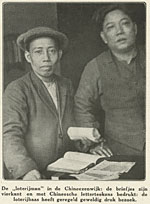
From Het Leven, 27 March 1922
Het Leven (Life) was already interested in the Chinese community, even in the years prior to the Second World War. On 27 March 1922, Het Leven opened with a report entitled 'In Rotterdam's Chinatown'. Here the elements, which would also later go on to fascinate the established Dutch society, could also be found, namely: the closeness of the community, the love of gambling and the opium.
On 7 January 1933, the magazine cover carried a large photo of a Chinese peanut seller, which reached up to the title, with the caption: 'Lekka... lekka... pinda...pinda' (tasty...tasty... peanut... peanut). A year later, on 24 March 1934 and on 7 April 1934, Het Leven published a two part report entitled 'Losing one's way from the Heavenly Kingdom: At the Chinese in Katendrecht'. A sign at a boarding house, which read 'Strongly forbidden for Dutchmen', had whetted the journalist's interest.
After the war, Sem Presser described and photographed the recovering community around the Binnen Bantammerstraat for the De Week in Beeld (The Week in Pictures) of 20 September 1947.
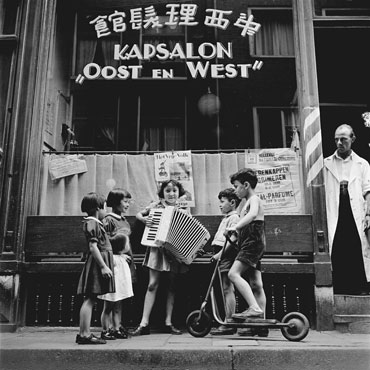
Amsterdam 1947, Chinese in the Binnen Bantammerstraat, Hairdressing salon 'Oost en West' (East and West), Chan Ching Hing family. Photo: Sem Presser/MAI.
Later, in 1966, Nico Polak produced a two page long reportage about the Binnen Bantammerstraat for Het Vrije Volk (The Free People) from which the following quote gives a good impression: 'Question 3: which typical Chinese institutions can be found in the Binnen Bantammerstraat and its surroundings? Answer: Eight Chinese restaurants for Dutch people, four gambling houses, two opium dens, several boarding houses, three unique neighbourhood cafes, a hairdresser specialising in Chinese hairstyles, two Indonesian grocers, three clubhouses for various groups of Chinese and four Chinese restaurants for Chinese people'.
The neighbourhood once again became the subject of a portrait in 1972; this time it was Ab Koers's photo report for Avenue from which a number of photos are shown here. Nico Polak devoted another background story to the murder of gambling house owner Chung Mon in 1975 in the HP magazine of 15 November of the same year. The photojournalistic interest in the Chinese community still continued after this, despite the fact that the Netherlands and especially Amsterdam bore witness to an enormous increase of more or less photogenic minorities.
Millie Low photographed the Binnen Bantammerstraat between 1981 and 1984. She was partly exploring her own roots as the child of a Chinese father and Dutch mother. Her work focused on the everyday lives of the Chinese, rather than the sensationalism of triad gangs or opium. These photographs were published in Plaatwerk in August 1984, issue 7. Many of her photos were also used for Gregor Benton and Hans Vermeulen's book De Chinezen (The Chinese) in 1987.
From October 23 1990 to January 6 1991 the Amsterdam Historical Museum staged an exhibition titled 'Dongfeng - Oostenwind' ('Dongfeng- Eastern Wind'). For this exhibition photographer Cor Jaring was commissioned to make a reportage on the Chinese of Amsterdam. Soon after, in May 1991, the IISH devoted attention to China and the Chinese in the Netherlands in the exhibition 'The past in fragments...'.
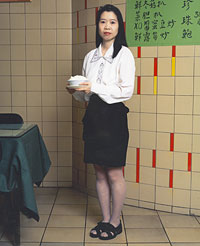
Hang Ying Fong, waiter at the Golden Chopsticks restaurant in de Damstraat.
Photo: Venus Veldhoen
A more recent testimony to the Chinese Netherlands can be found in the work of Venus Veldhoen. She was commissioned to produce the 'Amsterdam Chinese' series by the Amsterdam Fund for the Arts in 2000. This work was exhibited in 2001 at the Amsterdam Historical Museum under the title 'A dragon awakes'. The exhibition displayed photographs of the construction of the Chinese temple on the Zeedijk and the Chinese community in Amsterdam.
These photographs were also used in publications such as the M Magazine of the national newspaper the NRC/Handelsblad. Although this photo series also shows the exotic aspects of the Chinese minority in Amsterdam, the character is quite different. It reveals a relatively large, established, diverse and valued community in which the ethnic character is undisputed.
Ab Koers
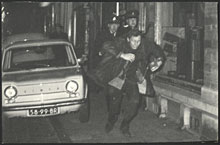
Ab Koers cornered by the police. Amsterdam, mid 1960s. Photo: Ron Kroon BG A62/162
Ab Koers was born on 14 October 1936. He worked as a photojournalist from 1960 to 2003. He began his career at the "Fototechnisch bureau van Es" and later he became a technician at Het Vrije Volk. From 1962 onwards, he worked at this paper as a photojournalist. From 1968 to 2003, Ab Koers worked as a freelance photographer. His photos have been published in Vrij Nederland, N.V.J.- De journalist, Aannemers / Bouwers and Viva.
Literature:
- Gregor Benton en Hans Vermeulen, De Chinezen (Muiderberg, 1987) (IISH call number: 1995/1615)
- Frank Bovenkerk en Lodewijk Brunt (eds.), 'Pinda-Chinezen' in: De rafelrand van Amsterdam (Meppel, 1977) (IISH call number: 125/168)
- Ingrid Groenen en Stefan landsberger (eds.), 'Waar de zon schijnt vindt men Chinezen'. China in Nederland (Amsterdam, 1986) (IISH call number: 331/96)
- F. van Heek, Chineesche immigranten in Nederland (Amsterdam, 1936) (IISH call number: 81/48)
- Oei Hong Kian, Kind van het land. Peranakan-Chinezen in drie culturen (Rotterdam, 1998) (IISH call number: 1998/4864)
- Frouke Wieringa , Dongfeng Oostenwind: Chinezen in Nederland (Amsterdam, 1990) (IISH call number: Bro 2886/20 fol)
- Wim Willems en Annemarie Cottaar, 'Chinezen', in: Het beeld van Nederland (Baarn, 1989) (IISH call number: 1990/2523)
- H.J.J. Wubben, "Chineezen en ander Aziatisch ongedierte". Lotgevallen van Chinese immigranten in Nederland, 1911-1940 (Zutphen, 1986) (IISH call number: 322/184)
- Yocklang Chong, De Chinezen van de Binnen Bantammerstraat. Een geschiedenis van drie generaties (Amsterdam, 2005) (IISH call number: 2006/212)
Reportages
- 'In de Rotterdamsche China-town' Het Leven 27 maart 1922 (IISH call number: ZK 52690)
- 'Lekka lekka pinda pinda' Het Leven 7 januari 1933
- 'Verdoolden uit het Hemelsche Rijk. Bij de Chineezen op Katendrecht', Het Leven
24 maart 1934 en 7 april 1934
- Sem Presser, 'China in Nederland', De week in Beeld 20 september 1947 8-9
- Nico Polak, 'De Binnen Bantammerstraat en de boze geest in de Hollandse gaper', Het Vrije Volk weekeindbijvoegsel Vrijuit 22 januari 1966
- Nico Polak en Ab Koers, 'De Chinezen van Amsterdam', Avenue februari 1973 42-53
- Nico Polak, 'Het nieuwe Chinatown van Amsterdam. Vijftig kilo horse uit Hongkong', HP 15 november 1975 42-48
- Chinezen in Amsterdam - foto's Millie Low. Interview Hans Aarsman. In Plaatwerk 1984 nr.7 augustus 8-19
- Elma Verhey, 'De Binnen Bantammerstraat', Vrij Nederland Bijvoegsel 14 september 1985 (IISH call number: ZK 40932)
Supplement
- Patrick Meershoek en Dingena Mol (foto's), 'De Oriënt in de Stormsteeg', Het Parool, PS van de Week 3 april 2010 14-19.
- Patrick Meershoek en Jean Pierre Jans (foto's), 'Mahjong bij Tung Lok is gezellig en nuttig', Het Parool (Amsterdam, September 25, 2010) 28-29.
- Aukelien Weverling en Jaymee Maguire (foto's) 'Hoera! Honderd jaar Chinezen', NL jrg 7 2010 nr.20 15-17.
